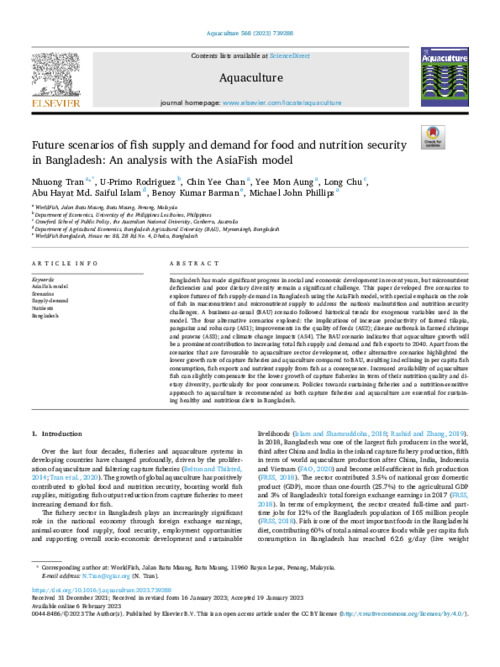Future scenarios of fish supply and demand for food and nutrition security in Bangladesh: An analysis with the AsiaFish model

Bangladesh has made significant progress in social and economic development in recent years, but micronutrient deficiencies and poor dietary diversity remain a significant challenge. This paper developed five scenarios to explore futures of fish supply-demand in Bangladesh using the AsiaFish model, with special emphasis on the role of fish in macronutrient and micronutrient supply to address the nation's malnutrition and nutrition security challenges. A business-as-usual (BAU) scenario followed historical trends for exogenous variables used in the model. The four alternative scenarios explored: the implications of increase productivity of farmed tilapia, pangasius and rohu carp (AS1); improvements in the quality of feeds (AS2); disease outbreak in farmed shrimps and prawns (AS3); and climate change impacts (AS4). The BAU scenario indicates that aquaculture growth will be a prominent contribution to increasing total fish supply and demand and fish exports to 2040. Apart from the scenarios that are favourable to aquaculture sector development, other alternative scenarios highlighted the lower growth rate of capture fisheries and aquaculture compared to BAU, resulting in declining in per capita fish consumption, fish exports and nutrient supply from fish as a consequence. Increased availability of aquaculture fish can slightly compensate for the lower growth of capture fisheries in term of their nutrition quality and dietary diversity, particularly for poor consumers. Policies towards sustaining fisheries and a nutrition-sensitive approach to aquaculture is recommended as both capture fisheries and aquaculture are essential for sustaining healthy and nutritious diets in Bangladesh.
Permalink
Date Available
Type
Publisher
Countries
ISSN
0044-8486
Copyright
CC-BY-4.0
Topics
Language